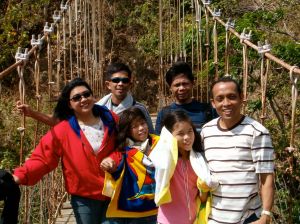






Lina and I arrived in the Philippines eight days ago. Since our arrival, a dear friend has died and our niece has given birth. Around each event a large supporting cast has come together to accompany the principals through their transitions.
Debbie found out she had advanced lung cancer while teaching English in Kazakhstan. She returned to the Philippines immediately and began alternative treatment at a clinic in Olangapo, north of Manila, where we saw her one year ago. Once she left the clinic she went home to Tabuk, the capital city of Kalinga Province in the north, and there her family cared for her and her friends visited her. The overnight bus arrives in Tabuk in the early morning, 10 to 14 hours after leaving Manila; visitors would usually return the same afternoon so as not to tax Debbie and her family. A 20 to 28 hour trip to visit a sick friend – what a gift of love!
A community of support grew around the family through Facebook, phone calls and text messages. Several dear friends visited her just last week, and on Saturday morning Debbie died. Five of us traveled up to Tabuk on Sunday night for the service and burial on Monday.
When we arrived, the wake was in progress, friends and neighbors gathered in a front room around her coffin, singing hymns and keeping Debbie company through the night. The family had slaughtered five pigs to feed those attending the vigil. Men were stirring a huge pot of boiling pork and cooking stew in a very large wok. A bonfire had been lit outside during the night to warm visitors. The vigil lasted until we slid the coffin into a hearse and walked behind it to the church half a mile away. After the service we traveled to the cemetery where Debbie was interred in an above ground crypt.
Lina has commented on the short visiting hours at many American funeral homes, compared to the longer vigil she is used to, often in a person’s home. She also expressed surprise at a graveside burial that no sooner had the priest said his last words than the mourners turned and headed for their cars. She told me that in the Philippines the mourners remain until the burial is complete.
And so it was in Tabuk. We watched the coffin slide into the crypt, Debbie’s father going in first to guide it into place – I was moved that he ushered his daughter into the grave. Many of us stayed to watch the masons close the door with cinder blocks and mortar, then spread a layer of cement over the rough surface. It was then time to return to the home for another meal and later take our leave.
If it takes a community to raise a child, it also takes a community to bury a daughter, sister and friend. The way this happens in the Philippines emphasizes our connection to the person who has died: we do not leave her alone until she is buried.
Yesterday morning our niece Erna delivered a little boy (and the family’s first grandchild) by Caesarean section in a small hospital several miles from our home. She had gone there from a “lying in” when the midwife decided it was time for the baby to be out.
Lina and I went over in the late afternoon with a friend visiting us from another island. A man at a small desk in front waved us back to the one room maternity ward where we found mother, father and baby with both grandparents. Erna was sleeping off the anesthetic still. We talked and joked and admired the new arrival once he was brought in from the nursery where he’d been getting special attention. The hospital is simple and clean, the staff attentive, and no one objected to five visitors crowding in to the small ward.
Erna and her husband and baby have probably not been alone at all today. At one point eight visitors were with them, not just family but friends and neighbors. This reminds me much more of the home birth environment in which I visited my two youngest grandchildren than the hospital environment so common in the US. Family brought food, carried on spirited conversation, laughed a lot. Family members also were helping Erna to begin to move (carefully), a task that nurses would have undertaken in the US.
I wondered whether the young couple might appreciate some privacy. But perhaps here it takes a village to bring a child into the world too.